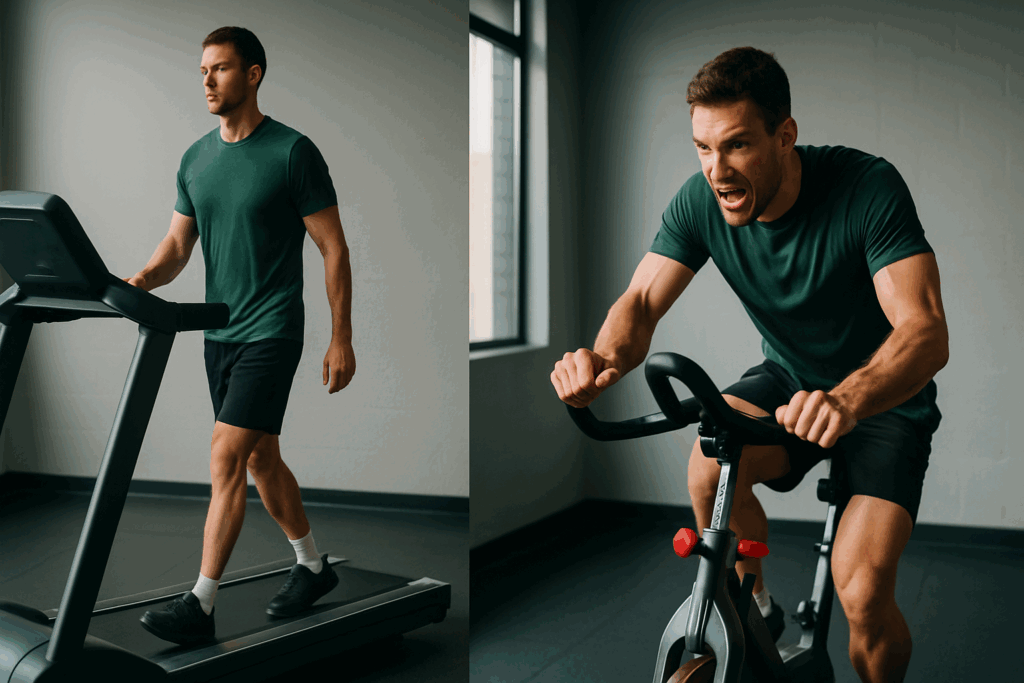Cardio vs. Strength: Are They Really Opposites?
Traditionally, cardio and strength training have been portrayed as antagonistic disciplines, rooted in fundamentally different physiological mechanisms. Cardiovascular exercise, such as running, cycling, or swimming, primarily relies on aerobic metabolism, enhancing the efficiency of the heart, lungs, and blood vessels. In contrast, strength training activates anaerobic pathways, requiring explosive bursts of power and inducing muscle hypertrophy through micro-tears and metabolic stress. While these two systems may appear to function independently, the truth is far more integrated.

Research has shown that moderate cardiovascular training can enhance recovery by improving blood flow, delivering nutrients to muscles, and reducing inflammation. Athletes who integrate both modalities—referred to as concurrent training—often report better overall conditioning, higher energy levels, and enhanced mental focus. The key is in how you structure your workouts. Timing, intensity, and the specific type of cardio all play a role in whether endurance work will support or sabotage your gains.
For example, performing 30 minutes of cardio a day at a low to moderate intensity can serve as an active recovery tool without impeding muscle repair or strength development. However, engaging in high-intensity cardio right before a heavy lifting session can fatigue the nervous system and compromise power output. This is why many strength coaches advise separating cardio and resistance training by several hours—or performing them on alternate days—to maximize results. Still, the question remains: can I do cardio everyday and still get stronger?
You may also like: The Ultimate Hypertrophy Workout Program for Building Strength and Size

Is It Good to Do Cardio Everyday for Muscle-Building Goals?
To truly evaluate whether it is good to do cardio everyday while pursuing muscle gains, we need to consider several variables, including intensity, duration, timing, and the individual’s training level. Cardio, in moderation and tailored to the individual’s capacity, can support strength-building efforts by improving metabolic efficiency, reducing recovery time, and aiding in fat loss. When cardio is low-impact—such as brisk walking, rowing, or cycling—it poses minimal risk to muscle preservation and can even enhance insulin sensitivity, a crucial factor in muscle protein synthesis.
However, daily high-intensity cardio, particularly if it is excessive in volume or performed without adequate nutrition, can lead to overtraining. Symptoms such as fatigue, poor sleep, mood disturbances, and decreased performance are warning signs that the body is not recovering sufficiently. For individuals asking, “should you do cardio every day?” the answer lies in context. If the goal is to enhance endurance, improve heart health, or increase overall energy expenditure without undermining strength progress, then yes—daily cardio can be beneficial, provided it is implemented wisely.
Athletes and bodybuilders often use light cardio as a tool during cutting phases to reduce body fat while maintaining lean mass. In these cases, understanding how much cardio should I do a day becomes vital to ensuring muscle isn’t compromised. For beginners, starting with 20 to 30 minutes of cardio a day at a moderate pace, five to six days per week, strikes a healthy balance between activity and recovery. Advanced lifters may vary their cardio frequency depending on competition schedules, training cycles, and body composition goals.

How Much Cardio a Day to Lose Weight Without Losing Strength
Weight loss and strength gain are not mutually exclusive, but they do require a delicate balance. To lose fat while preserving muscle, you must maintain a calorie deficit while providing your body with sufficient protein, sleep, and resistance-based stimulation. Cardio becomes an accelerant in this process, helping burn additional calories and improve metabolic flexibility. But how much cardio a day to lose weight without sacrificing strength gains?
The American College of Sports Medicine recommends 150 to 300 minutes of moderate-intensity cardio per week for significant weight loss. This translates to approximately 30 to 60 minutes per day, five days a week. However, this guideline must be individualized. If your primary goal is muscle retention or hypertrophy, you may want to stick closer to the lower end of that range and focus on nutrient timing to support recovery. Cardio sessions that exceed an hour or are combined with insufficient food intake can lead to catabolism—the breakdown of muscle tissue for energy.
A more strategic approach involves alternating between steady-state cardio and high-intensity interval training (HIIT), which has been shown to promote fat oxidation and preserve lean mass. By varying your cardio routine, you reduce the risk of adaptation, boredom, and overuse injuries. Monitoring how often should I do cardio versus how often to work out with weights allows for optimal scheduling. Listening to your body and adjusting based on performance metrics—such as strength levels, body composition, and recovery quality—can help maintain a steady trajectory toward both fat loss and muscular strength.

The Role of Physical Activity Guidelines in Shaping Daily Cardio Habits
Understanding and applying evidence-based physical activity guidelines can offer clarity on whether daily cardio supports or undermines your training objectives. The U.S. Department of Health and Human Services recommends at least 150 minutes of moderate-intensity or 75 minutes of vigorous-intensity aerobic activity per week for adults, along with two or more days of strength training. These benchmarks offer a foundational blueprint but do not account for individual variability, performance goals, or existing training loads.
For someone already performing resistance training five times per week, the addition of cardio should be calibrated carefully. If you’re wondering how long should you workout a day, the answer hinges on balancing intensity and recovery. Exceeding the maximum workout time per day—often cited as around 90 minutes for high-effort sessions—can result in diminishing returns. This is especially true when both strength and cardio are attempted within the same window. Spacing sessions or dedicating different days to different modalities may prove more effective.
Adhering strictly to these guidelines without considering the interaction between different types of training can lead to overreaching. Instead, the physical activity guidelines should serve as a flexible framework that encourages consistency and adaptability. You can tailor them to your needs by including lighter cardio on your rest days, incorporating active hobbies like hiking or swimming, or using cardio as a warm-up and cooldown around your lifting sessions. This approach helps mitigate fatigue while aligning with both health and performance goals.

Should I Do Cardio Everyday? Exploring the Science Behind Frequency
The question “should I do cardio everyday?” invites a nuanced answer, shaped by scientific evidence and individual differences. Cardiovascular exercise confers numerous health benefits—lower blood pressure, improved lipid profiles, reduced risk of chronic disease—but the frequency with which it’s performed must align with personal goals. In strength training contexts, the primary concern lies in ensuring that cardio doesn’t compromise muscular adaptations or interfere with recovery from resistance sessions.
Studies have shown that concurrent training—the integration of cardio and strength—can reduce hypertrophy outcomes if the cardio is too intense, too long, or scheduled too closely to lifting. However, the interference effect is not universal. It depends on variables like training age, nutritional status, and exercise modality. For example, cycling is often better tolerated than running due to reduced impact on joints and less muscle damage.
Frequently Asked Questions (FAQ) About Daily Cardio and Strength Training
Is It Good to Do Cardio Everyday When Building Strength?
Yes, it can be—but only if approached strategically. Performing cardio every day may support strength training goals when done at a low to moderate intensity and integrated properly into your schedule. Daily light cardio can improve blood circulation, accelerate recovery, and help regulate insulin sensitivity, which indirectly benefits muscle growth. However, when cardio intensity is too high or performed too close to your strength sessions, it can interfere with recovery and muscle protein synthesis. To make daily cardio work for strength, prioritize session timing, adjust nutrition accordingly, and use modalities like walking or cycling that are less taxing on the central nervous system.
Can I Do Cardio Everyday Without Harming My Joints?
You absolutely can, provided you make smart choices about the type and intensity of cardio. Low-impact exercises such as swimming, rowing, or elliptical workouts are excellent for preserving joint health while still offering cardiovascular benefits. High-impact cardio, like running on hard pavement, done every day without variation can lead to joint strain or overuse injuries. A smart approach is to rotate modalities throughout the week and include recovery strategies such as mobility drills or foam rolling. If your goal includes 30 minutes of cardio a day, opt for surface-friendly environments like turf tracks or cushioned treadmills, and always listen to feedback from your body.
How Long Should I Do Cardio If I Want to Support Muscle Gain?
The optimal cardio duration varies, but generally, 20 to 40 minutes is enough to support metabolic conditioning without impeding muscle development. For most people, especially those lifting four or more times a week, shorter sessions around 20 to 25 minutes work best. This gives your body enough time to gain the cardiovascular benefits while preserving energy for weight training. Those wondering how long should I do cardio should also consider splitting sessions—performing 15 minutes in the morning and 15 post-lift, for instance, can be metabolically effective. As always, intensity should align with your recovery capacity and total weekly workload.
Is 30 Minutes of Cardio Enough for Fat Loss and Strength?
Yes, 30 minutes of cardio a day can be enough for fat loss, especially when paired with resistance training and a calorie-controlled diet. The key lies in consistency, exercise selection, and dietary adherence. Low-intensity steady-state (LISS) cardio at this duration is ideal for burning fat while minimizing cortisol spikes that could hinder muscle growth. Moreover, incorporating varied pacing or terrain, like uphill walking or biking, can help maximize caloric output in less time. So, is 30 minutes of cardio enough? For most people aiming for fat loss while preserving muscle, it is more than sufficient when well programmed.
How Often Should I Do Cardio During a Strength Program?
Understanding how often should I do cardio while lifting heavily depends on your recovery rate, training intensity, and goals. A good starting point is three to four sessions per week, gradually increasing frequency as your conditioning improves. For those in a fat loss phase, up to six days of light cardio may be appropriate, provided you’re not in a recovery deficit. Athletes may periodize their training, performing more cardio during the off-season and tapering during peak strength blocks. Integrating active recovery days helps bridge the gap between how often to work out and how often should you workout to prevent plateaus.
Should You Do Cardio Every Day If You’re Trying to Bulk?
This is a tricky balance. While daily cardio can aid in appetite regulation, digestion, and cardiovascular health, excessive energy expenditure during a bulking phase may make it harder to stay in a calorie surplus. So, should you do cardio every day while bulking? Only if it’s low-impact, brief, and appropriately spaced from resistance training. Think 15-20 minutes of incline walking or cycling done several hours apart from lifting. If you’re struggling to eat enough, consider cutting back to three or four cardio sessions per week and reassess based on your progress and energy levels.
Understanding the Real Answer to “Is It Good to Do Cardio Everyday” for Longevity
From a longevity and health-span perspective, yes—it is good to do cardio everyday, provided it’s not done to extremes. Daily movement improves heart health, blood sugar control, mood regulation, and overall resilience against chronic disease. Light daily cardio also promotes better sleep quality and stress management, both crucial for long-term strength and vitality. However, the goal isn’t intensity—it’s consistency. Practices like walking after meals or cycling to work fulfill the intent behind the question: is it good to do cardio everyday for health? The answer is a resounding yes, as long as you manage fatigue and maintain nutritional balance.
How Much Cardio Per Week Helps Balance Strength and Conditioning?
A balanced approach typically involves 150 to 180 minutes of cardio per week, divided into 4–6 manageable sessions. Those curious about how much cardio per week is ideal should focus on the synergy between modalities. Pairing cardio with strength-based circuits or functional training allows for crossover benefits like improved lactate clearance and stamina under load. Over time, this conditioning supports better lifting performance by reducing rest periods and enhancing muscular endurance. The trick is to keep the cardio varied—think swimming one day, biking the next—ensuring the nervous system stays fresh while reaping diverse adaptations.
How Many Days a Week Should I Workout to Maximize Strength and Heart Health?
For most people, four to five days of resistance training paired with two to four days of cardio is a sustainable and effective rhythm. When considering how many times a week should I workout, it’s important to factor in intensity and volume. For example, a split that includes two upper-body and two lower-body sessions alongside brisk walks or interval bike rides can offer balanced development. Don’t forget rest is part of the plan—strategically placed off days can make your workouts more effective by reducing inflammation and enhancing neurological recovery. The sweet spot often lies where progression meets rest and variety.
Is It OK to Do Cardio Everyday While Following Physical Activity Guidelines?
Yes, and in fact, it aligns closely with official physical activity guidelines, which recommend daily movement as part of a healthy lifestyle. Whether you’re hitting the gym or doing yoga at home, daily movement is encouraged—just be sure to vary the intensity to avoid overstressing the body. Asking, “is it ok to do cardio everyday?” is like asking if it’s okay to walk your dog each morning—it absolutely is, but it shouldn’t leave you exhausted. Monitoring heart rate variability (HRV), mood, and energy can help ensure your approach stays beneficial. Ultimately, the question shifts from should I do cardio everyday to how do I do it smartly—and that’s where long-term success is found.

Conclusion: Integrating Daily Cardio for Optimal Strength and Health
So, is it good to do cardio everyday? The answer lies in your goals, your recovery capacity, and your programming strategy. Cardio, when done intelligently, can complement strength training by enhancing circulation, supporting fat loss, and contributing to overall health. However, intensity, volume, and timing must be monitored carefully to avoid the interference effect.
Whether you’re striving for muscle hypertrophy, general fitness, or metabolic health, striking the right balance between cardio and strength is essential. If you’re incorporating 30 minutes of cardio a day, ensure it’s tailored to your recovery status and energy availability. Ask yourself: how long should I do cardio to support my strength goals? How often should I do cardio without overreaching? And, most importantly, how does my body respond?
For many individuals, a combination of resistance training four to five days a week with low to moderate intensity cardio on most days—ranging from brisk walking to light cycling—can deliver the best of both worlds. The goal isn’t to pit cardio against strength but to understand their synergy. By aligning your training with scientifically grounded physical activity guidelines and adjusting based on your experience, you can safely answer: yes, it is good to do cardio everyday—if done with purpose and precision.
Further Reading:
How Often Should You Work Out?





